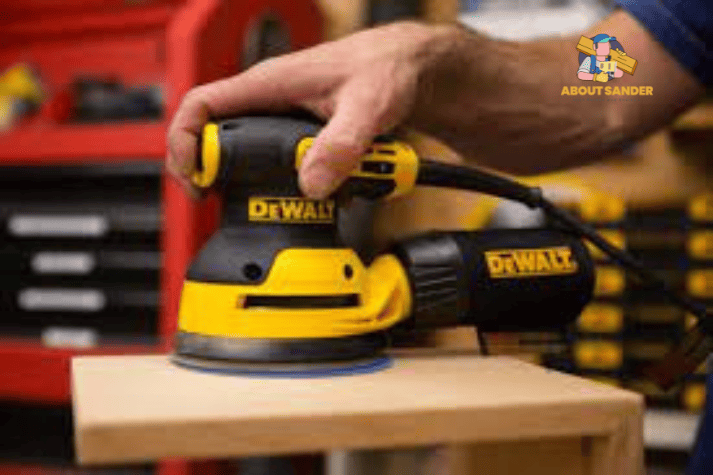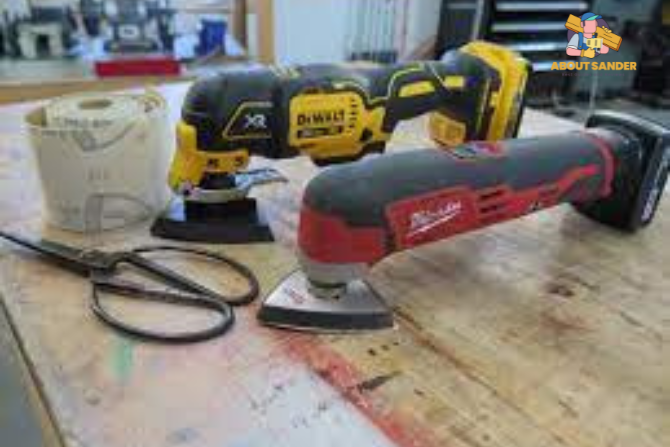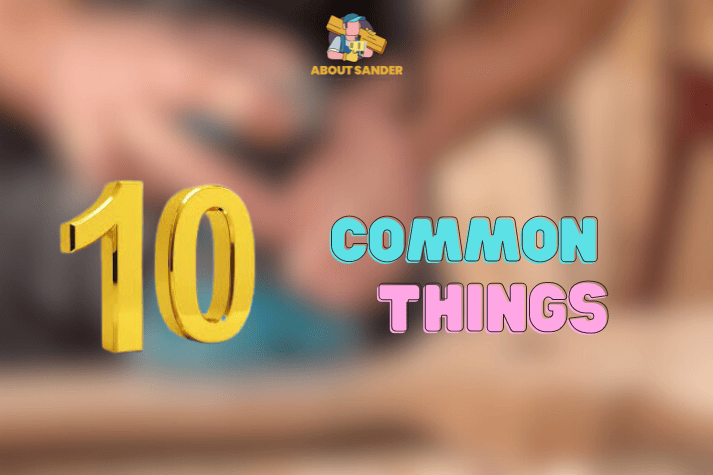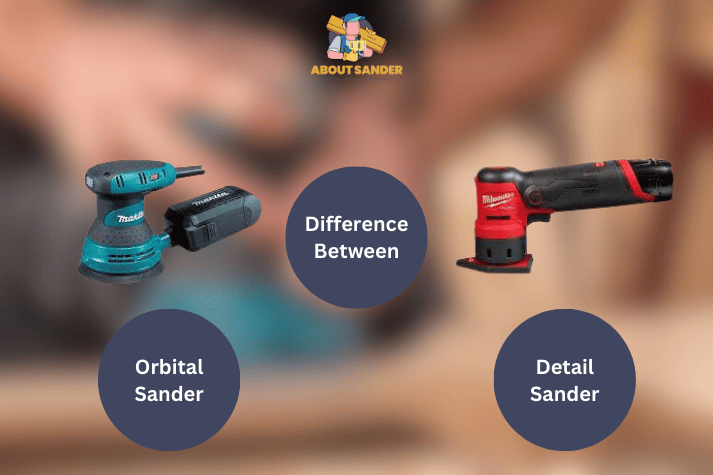The difference between an Orbital Sander and a Detail Sander is simple: An orbital sander is a versatile power tool that sands surfaces in a circular motion, ideal for large, flat areas. In contrast, a detail sander is designed for precision work, featuring a triangular sanding pad for intricate and tight spaces.
Orbital Sander or Detail Sander? Understand the Difference between an Orbital Sander and a Detail Sander, and find out which suits your sanding needs perfectly. Looking to upgrade your sanding game? Learn the difference between an Orbital Sander and a Detail Sander to optimize your projects and quickly achieve professional-level finishes.
Key Takeaways:


- Orbital Sander and a Detail Sander has different sanding motions and applications. Orbital Sanders are ideal for larger flat surfaces and quick material removal, while Detail Sanders excel at precise sanding in tight spots and intricate details.
- Both sanders share features, including dust collection systems, variable speed controls, and ergonomic designs, contributing to their overall efficiency and user comfort.
- When using either sander, selecting the correct sandpaper grit, preparing the surface properly, and using proper sanding techniques are essential for achieving optimal results.
- Orbital Sanders are more suitable for heavy material removal and larger projects, while Detail Sanders are perfect for fine finishing and intricate woodworking tasks.
- Prioritize safety by wearing appropriate protective gear, such as safety goggles and dust masks, and follow manufacturer guidelines to ensure a secure and enjoyable sanding experience.
Comprehensive Comparison between an Orbital Sander and a Detail Sander
With many sanding tools available, it’s essential to understand the key difference between an Orbital Sander and a Detail Sander to choose the right one for your specific needs. This comprehensive comparison will delve into the distinctions between the Orbital Sander and a Detail Sander, shedding light on their unique features, applications, and advantages.
| Aspect | Orbital Sander | Detail Sander |
| Sanding Motion | Random Orbital Motion | Focused Orbital Motion |
| Ideal Applications | Larger Flat Surfaces, Quick Material Removal | Precise Sanding in Tight Spots |
| Sanding Pad Size | Typically 4 to 6 inches in diameter | Usually 3 to 4 inches wide |
| Versatility | Suitable for Large-Scale Sanding Projects | Perfect for Detailed Woodworking |
| Material Removal Rate | High | Moderate |
| Dust Collection | Effective Dust Collection Systems | Dust Collection Capability |
| Use in Corners and Edges | Limited | Excellent for Navigating Tight Areas |
| Weight and Portability | Larger and Heavier | Lightweight and More Portable |
| Ideal for Finishing | Coarse to Fine Finishing | Delicate and Fine Finishing Work |
| Noise Level | May Produce Higher Noise Levels | Generally Quieter O\\\\\\\\peration |
1. Sanding Motion:
The sanding motion of a sander plays a significant role in determining the finish quality and the range of tasks it can perform.
Orbital Sander: The Orbital Sander is renowned for its random orbital sanding motion, wherein the sanding pad moves in a circular pattern while simultaneously spinning on its axis. This dual-action movement minimizes swirl marks and ensures a smoother finish.
Detail Sander: In contrast, the Detail Sander, also known as a Mouse Sander, features a triangular sanding pad that primarily moves in an orbital manner. This focused orbital motion allows precise sanding in tight spaces and corners that would be challenging for a standard Orbital Sander to reach.
2. Sanding Pad Size:
The size of the sanding pad can impact the efficiency and suitability of a sander for different projects.
Orbital Sander: The Orbital Sander typically comes with a larger sanding pad, ranging from 4 to 6 inches in diameter. This larger surface area allows for quicker material removal, making it suitable for sanding larger flat surfaces efficiently.
Detail Sander: In contrast, the Detail Sander boasts a smaller sanding pad, usually around 3-4 inches wide. This compact size provides better control and allows you to navigate intricate details and delicate areas easily.
3. Versatility:
The versatility of a sander determines its ability to handle various sanding tasks and materials.
Orbital Sander: With its larger sanding pad and robust sanding motion, it removes material quickly and efficiently, making it ideal for large-scale sanding projects, such as sanding down tabletops or wooden floors.
Detail Sander: The Detail Sander’s handy size and orbital motion cater to precise and intricate sanding tasks. It is perfect for refinishing furniture, sanding window frames, or working on decorative woodwork that requires careful attention to detail.
4. Material Removal Rate:
The material removal rate is crucial, as it impacts the speed and efficiency of sanding tasks.
Orbital Sander: Its random orbital motion and larger sanding pad make it more aggressive in material removal. It can quickly flatten uneven surfaces and remove paint or varnish effectively.
Detail Sander: While the Detail Sander is less aggressive than the Orbital Sander, its purpose is not to remove large amounts of material. Instead, it excels at fine sanding and preparing surfaces for finishing coats.
5. Dust Collection:
Efficient dust collection is essential for maintaining a clean working environment and improving visibility during sanding.
Orbital Sander: Many Orbital Sanders are equipped with efficient dust collection systems, such as dust bags or canisters. These systems help minimize airborne dust, improving your work area and promoting a healthier working environment.
Detail Sander: Detail Sanders often feature dust collection capabilities, ensuring that dust is captured during the sanding process. This prevents dust from settling on your workpiece and allows for better visibility of the sanding area.
6. Sandpaper Attachment:
Attaching sandpaper to the sander can impact the ease of use and efficiency during sandpaper changes.
Orbital Sander: The Orbital Sander typically uses Velcro or hook-and-loop sandpaper attachments, which make changing sandpaper sheets quick and easy. This feature increases efficiency during sandpaper replacements, allowing you to focus more on your project.
Detail Sander: The Detail Sander utilizes hook-and-loop sandpaper attachments, simplifying sandpaper changes and ensuring a secure fit for accurate sanding in tight spots.
7. Power Source:
The power source of a sander influences its portability and the convenience of use in different settings.
Orbital Sander: Orbital Sanders are available in both corded and cordless variations. Corded models offer consistent power throughout the sanding process, while cordless models provide greater mobility, making them suitable for projects without a nearby power source.
Detail Sander: Detail Sanders are predominantly corded due to their intended precision work. A continuous power supply is crucial for maintaining control during intricate sanding tasks.
8. Weight and Ergonomics:
The weight and ergonomics of a sander can affect user comfort and maneuverability during extended sanding sessions.
Orbital Sander: Orbital Sanders tend to be larger and heavier, which can lead to fatigue during extended use. However, many modern models feature ergonomic designs with comfortable grips, mitigating hand fatigue.
Detail Sander: Detail Sanders are more lightweight and compact, making them easier to maneuver around intricate details and tight spaces. Their ergonomic design further enhances user comfort during delicate sanding applications.
9. Cost:
The cost of a sander is an essential consideration for budget-conscious buyers and professionals alike.
Orbital Sander: Orbital Sanders typically fall into a higher price range due to their larger size and more robust capabilities. However, they offer excellent value for money for heavy-duty sanding tasks.
Detail Sander: Detail Sanders are generally more affordable, making them an accessible option for hobbyists and those focused on intricate woodworking projects.
10. Noise Level:
Noise level is a significant factor for the user’s comfort and safety during sanding operations.
Orbital Sander: The Orbital Sander’s larger motor and sanding pad may increase the noise level during operation. Hearing protection is advisable, especially when using the sander for prolonged periods.
Detail Sander: With its smaller size and focused sanding motion, the Detail Sander tends to produce less noise during operation. Nonetheless, hearing protection is still recommended for extended use.
Understanding the difference between an Orbital Sander and a Detail Sander is crucial for selecting the right tool that complements your woodworking requirements. Whether you need to tackle substantial sanding tasks or perform intricate finishing touches, these sanders offer distinct advantages to meet your project demands.
10 Things in Common between an Orbital Sander and a Detail Sander

As woodworking enthusiasts and professionals seek to achieve flawless finishes, understanding the difference between an Orbital Sander and a Detail Sander becomes essential. In this expert analysis, we will explore ten things that Orbital Sander and a Detail Sander have in common, shedding light on their overlapping functionalities and benefits.
1. Sanding Principle:
The Orbital Sander and the Detail Sander operate based on an orbital sanding principle. This means their sanding pads move in an elliptical or circular motion, eliminating the risk of creating swirl marks on the work surface. The orbital sanding principle is inherently designed to deliver smoother finishes, regardless of the size or type of sanding pad used.
2. Sanding Pad Attachments:
Orbital Sander and a Detail Sander typically utilize hook-and-loop sandpaper attachments. This convenient system allows for quick and effortless sandpaper changes. The hook-and-loop attachment ensures that the sandpaper stays securely in place during operation, minimizing the risk of slippage and enhancing overall sanding performance.
3. Dust Collection Systems:
Efficient dust collection is a shared priority for both sanders. The Orbital Sander and the Detail Sander often come equipped with dust collection features, such as dust bags or canisters. These systems are crucial in maintaining a clean and healthy work environment by capturing and containing the airborne dust generated during sanding.
4. Variable Speed Control:
Both types of sanders often offer variable speed control settings. This feature allows users to adjust the sanding speed according to their specific requirements and the type of material being worked on. Being able to fine-tune the sanding speed provides greater control and helps prevent accidental material removal, especially in delicate projects.
5. Ergonomic Design:
Orbital Sanders and Detail Sanders are designed with user comfort in mind. Manufacturers understand the importance of ergonomics during extended sanding sessions, and as a result, many models feature comfortable grip handles and well-balanced designs. This focus on ergonomics minimizes hand fatigue, allowing users to work for more extended periods without discomfort.
6. Compatibility with Sandpaper Grits:
Both sanders can accommodate sandpaper grits, making them versatile tools for sanding tasks. Whether you need to remove rough surfaces with coarse grits or achieve a smooth finish with fine grits, the Orbital Sander and the Detail Sander can easily handle the job.
7. Suitable for Wood and Non-Wood Materials:
Both sanders are not limited to woodworking applications only. They can be used on various materials, including metal, plastic, and even certain types of stone. This adaptability makes them valuable assets for different DIY and renovation projects.
8. Compatibility with Dust Extraction Systems:
While Orbital Sanders and Detail Sanders often come with their dust collection systems, they can also be connected to external dust extraction units. This option allows users to maintain a cleaner workspace and reduces airborne dust generated during sanding, contributing to a healthier working environment.
9. Versatility in Finishing:
Both sanders are adept at finishing tasks. Whether you need to prepare surfaces for paint, stain, varnish, or refine rough edges and details, the Orbital Sander and the Detail Sander deliver consistent results. Their versatility in finishing makes them indispensable tools for professionals and hobbyists alike.
10. Essential Safety Features:
Orbital and Detail Sanders have safety features designed to protect users during operation. These may include dust-sealed switches, anti-vibration technology, and overheat protection. These safety measures prioritize user well-being and ensure a secure and reliable sanding experience.
i. Dust-Sealed Switch:
The dust-sealed switch is a vital safety feature in the Orbital and Detail Sander. This design prevents dust and debris from infiltrating the switch, ensuring consistent and reliable operation even in dusty working conditions. Keeping dust away from electrical components minimizes the risk of electrical malfunctions or short circuits, enhancing overall user safety.
ii. Anti-Vibration Technology:
Both sanders are often equipped with anti-vibration technology. This feature mitigates the vibrations generated during sanding, reducing strain on the user’s hands and arms. By minimizing hand fatigue, the anti-vibration technology enhances user comfort and improves overall control, preventing accidental slips and potential injuries.
iii. Overload Protection:
Orbital Sanders and Detail Sanders commonly come with overload protection mechanisms. When the sander is pushed beyond its operating capacity, such as excessive pressure on the sanding pad or using an unsuitable grit for the material, the overload protection automatically shuts down the tool. This safeguard prevents motor burnout and protects the user from potential hazards.
iv. Dust Collection Systems:
While dust collection systems are essential for maintaining a clean work environment, they also play a significant role in user safety. Both sanders often feature effective dust collection systems, such as dust bags or canisters. These systems reduce airborne dust and minimize the risk of inhaling harmful particles, promoting a healthier working environment.
v. Trigger Lock Mechanism:
Orbital Sanders and Detail Sanders commonly have a trigger lock mechanism. This feature allows users to lock the power switch in the “on” position, freeing their hands for more comfortable sanding in prolonged projects. When not in use, engaging the trigger lock prevents accidental activation, preventing potential accidents when handling or storing the tool.
vi. Ergonomic Handle Design:
An ergonomic handle design is a crucial safety feature shared by both sanders. The handle’s ergonomic shape and comfortable grip reduce strain on the user’s hands and wrists, minimizing the risk of repetitive stress injuries during extended sanding sessions. An ergonomic handle design ensures better control over the sander, enhancing overall safety and performance.
vii. Soft Start Function:
The soft start function is commonly integrated into Orbital Sanders and Detail Sanders. This feature ensures the sander starts slower, gradually reaching the selected speed setting. The smooth start function prevents sudden jolts or kickbacks, providing users with better control and reducing the risk of potential mishaps during sanding.
viii. Dust Extraction Port:
In addition to the built-in dust collection systems, both sanders often come with a dust extraction port. This port lets users connect the sander to external dust collection systems, such as a vacuum cleaner. By directing dust away from the work area, the dust extraction port contributes to better visibility, reducing the likelihood of accidents caused by obscured vision.
ix. Non-Slip Rubber Feet:
Both sanders are typically equipped with non-slip rubber feet. These feet provide stability during sanding, preventing the sander from moving or sliding unexpectedly. The enhanced strength ensures precise sanding, reducing the chances of the sander slipping and causing damage to the workpiece or posing risks to the user.
x. Transparent Dust Canister or Dust Bag:
Many Orbital Sanders and Detail Sanders have a transparent dust canister or dust bag. This feature allows users to monitor the dust collection level, knowing when it needs to be emptied. A fine dust canister or bag helps maintain optimal dust collection efficiency, ensuring a cleaner work area and better respiratory safety.
10 tips for using both sanders safely

In this expert guide, we will provide ten tips for using both the Orbital Sander and a Detail Sander, covering best practices and techniques to optimize your sanding results.
1. Select the Right Grit:
The first step to successful sanding with either sander is choosing the appropriate sandpaper grit. Start with a coarse grit (around 60-80) with the Orbital Sander for rough material removal. For finer finishing, switch to medium grits (100-150). With the Detail Sander, use fine grits (150-220) for delicate projects. Always match the sandpaper grit to your specific sanding task for efficient and accurate results.
2. Prepare the Surface:
Before using either sander, ensure the work surface is clean and free from debris or protruding nails. For detailed work, consider removing any hardware or attachments that might hinder sanding in tight areas. Proper surface preparation ensures smooth and uniform sanding across the entire workpiece.
3. Hold the Sander Firmly:
Whether using an Orbital Sander or a Detail Sander, maintain a firm grip on the tool while sanding. Avoid excessive pressure, which may cause uneven sanding or excessive material removal. Let the sander’s weight and motion work, guiding it evenly across the surface for consistent results.
4. Start and Stop Smoothly:
Avoid starting or stopping the sander on the workpiece itself when using an Orbital Sander. Instead, please turn on the sander and let it reach full speed before placing it on the material. Similarly, lift the sander off the surface before turning it off to prevent accidental sanding marks.
5. Overlap Strokes for Even Sanding:
To ensure even sanding coverage, overlap each stroke slightly with the previous one. This technique applies to the Orbital and Detail Sander, creating a smooth and uniform finish across the workpiece.
6. Move with the Grain:
When sanding wooden surfaces, it’s essential to move the sander with the grain of the wood. Sanding against the grain can result in scratches and damage to the wood fibers. Following the wood grain direction ensures a seamless and professional-looking sanding outcome.
7. Pay Attention to Corners and Edges:
Both sanders excel in their abilities to reach tight corners and edges. When using the Detail Sander, apply gentle pressure and maneuver the sander carefully in intricate areas to achieve precise sanding. For larger corners and edges, an Orbital Sander with a sanding pad designed for corner sanding can be a valuable tool.
8. Keep the Sander in Motion:
To avoid creating sanding marks or uneven patches, always keep the sander in motion while in contact with the workpiece. Prolonged standing in one spot can lead to over-sanding, especially with the Orbital Sander, resulting in a dip or groove in the material.
9. Sand in Sequence:
When working on larger surfaces, it’s best to sand in a sequence from coarse to fine grits. Start with the Orbital Sander using a coarse grit to remove material quickly, then switch to finer grits with both sanders for a smooth and polished finish.
10. Use Safety Gear:
Lastly, prioritize safety while using either sander. Wear appropriate safety gear, including safety goggles or a face shield to protect your eyes from flying debris. Dust masks or respirators are crucial for respiratory protection, especially when working in dusty environments.
FAQs For Understanding the difference between an Orbital Sander and a Detail Sander
This FAQ section addresses common questions that often arise when discussing the difference between an Orbital Sander and a Detail Sander. These sanders serve distinct sanding purposes, and understanding their unique features will help you make informed decisions for your woodworking projects.
1: What is the primary difference between an Orbital Sander and a Detail Sander?
The main difference lies in their sanding motion and application. An Orbital Sander operates with a random orbital motion, suitable for larger flat surfaces and quick material removal. On the other hand, a Detail Sander has a focused orbital motion, designed for precise sanding in tight spots and intricate details that require delicate handling.
2: Can both sanders be used for the same projects?
While some applications may overlap, each sander is specifically tailored for different tasks. Orbital Sanders excels in sanding larger surfaces, like tabletops and wooden floors, where material removal speed is essential. Detail Sanders are best suited for fine sanding and intricate work, such as refinishing furniture, window frames, or decorative woodwork.
3: Which sander should I choose for my project?
Selecting the appropriate sander depends on the nature of your project. An Orbital Sander is the better choice if you need to tackle substantial sanding tasks or cover larger areas quickly. A Detail Sander is the ideal option if you are working on detailed woodworking projects requiring precision sanding.
Conclusion:
Get a grip on woodworking equipment! Dive into our article, Understanding the difference
between an Orbital Sander and a Detail Sander, to discern the features that set these tools apart and enhance your craftsmanship. Our detailed explanation on Understanding the difference between an Orbital Sander and a Detail Sander will help you make an informed choice for your DIY tasks.”

Why Trust About Sanders?
When it comes to the world of sanding and sanders, you need a trusted source of information and guidance to ensure you achieve those perfect finishes. That's where I come in – I'm Martin, a dedicated sanding enthusiast with a relentless passion for attaining flawless surfaces. With years of hands-on experience in the sanding industry, I've honed my skills and expertise to provide you with the most reliable and accurate insights. What sets me apart is my commitment to excellence. I meticulously handpick each sander after rigorous testing, ensuring that only the best tools make it to your hands. My goal is to empower you with the knowledge and recommendations you need to tackle any sanding task confidently. When you trust About Sanders, you're putting your faith in a seasoned expert who shares your passion for perfection and strives to deliver top-notch information and reviews for every sanding challenge.
